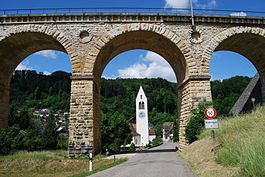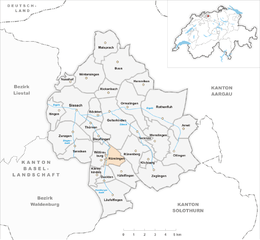Rümlingen
| Rümlingen | ||
|---|---|---|
 |
||
|
||
| Coordinates: 47°26′N 7°51′E / 47.433°N 7.850°ECoordinates: 47°26′N 7°51′E / 47.433°N 7.850°E | ||
| Country | Switzerland | |
| Canton | Basel-Landschaft | |
| District | Sissach | |
| Area | ||
| • Total | 2.28 km2 (0.88 sq mi) | |
| Elevation | 459 m (1,506 ft) | |
| Population (Mar 2016) | ||
| • Total | 386 | |
| • Density | 170/km2 (440/sq mi) | |
| Postal code | 4444 | |
| SFOS number | 2859 | |
| Surrounded by | Buckten, Gelterkinden, Häfelfingen, Rünenberg, Wittinsburg | |
| Website |
http://www.ruemlingen.ch SFSO statistics |
|
Rümlingen is a municipality in the district of Sissach in the canton of Basel-Country in Switzerland.
Rümlingen is first mentioned in 1358 as Rumelikon.
Rümlingen has an area, as of 2009[update], of 2.28 square kilometers (0.88 sq mi). Of this area, 1.08 km2 (0.42 sq mi) or 47.4% is used for agricultural purposes, while 0.92 km2 (0.36 sq mi) or 40.4% is forested. Of the rest of the land, 0.24 km2 (0.093 sq mi) or 10.5% is settled (buildings or roads), 0.03 km2 (7.4 acres) or 1.3% is either rivers or lakes.
Of the built up area, industrial buildings made up 1.3% of the total area while housing and buildings made up 5.3% and transportation infrastructure made up 3.9%. Out of the forested land, all of the forested land area is covered with heavy forests. Of the agricultural land, 25.0% is used for growing crops and 18.9% is pastures, while 3.5% is used for orchards or vine crops. All the water in the municipality is flowing water.
The municipality is located in the Sissach district, in the Homburger valley.
The blazon of the municipal coat of arms is Or, St. George armoured Azure, haired of the first, haloed and holding a spear Gules topped Argent, slaying a Dragon Sable, toothed Argent and eyed Gules.
Rümlingen has a population (as of March 2016[update]) of 386. As of 2008[update], 23.3% of the population are resident foreign nationals. Over the last 10 years (1997–2007) the population has changed at a rate of 9.6%.
Most of the population (as of 2000[update]) speaks German (259 or 80.7%), with Serbo-Croatian being second most common (19 or 5.9%) and Albanian being third (18 or 5.6%). There is 1 person who speaks French.
...
Wikipedia




